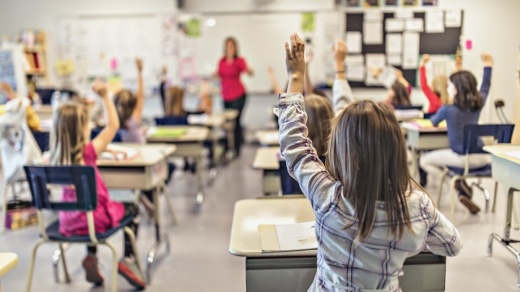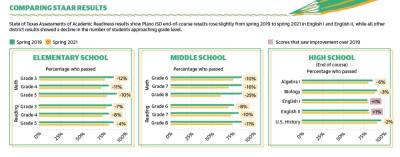The district is required to spend at least 20% of the grants to address learning loss. While that can take different forms for different students, the decreases in State of Texas Assessments of Academic Readiness scores for PISD students were a tangible sign of the pandemic’s effect on education.
Results released in June show across-the-board decreases in the number of PISD elementary and middle school students who passed STAAR compared to 2019.
STAAR was canceled in spring 2020 due to the pandemic.
Middle school math scores saw a 25 percentage point drop in the number of PISD eighth-grade students who passed from 2019 to 2021.
Texas Education Commissioner Mike Morath said the statewide STAAR scores were “problematic” and called the state school system damaged due to the pandemic during a June 23 State Board of Education meeting.
Under requirements passed by the Texas Legislature this year, he said school districts have to create a written plan to accelerate learning for students who did not meet grade-level expectations in third, fifth and eighth grades.
In addition to such a plan, the district intends to use the federal funds to help retain teachers with more than six years of experience.
“[Those teachers] are our best prayer for recovering learning loss,” Superintendent Sara Bonser said during the June 22 PISD board of trustees meeting.
STAAR experiences
Students had to take the exams in person, though some opted not to take it. PISD officials said just 77% of the students in grades that were supposed to take STAAR did so during the spring semester.
PISD is part of the state’s Region 10 Education Service Center, which offers professional development and other assistance to North Texas school districts. Region 10 Executive Director Gordon Taylor said the drop in STAAR scores was expected due to pandemic-related disruptions. However, he cautioned against comparing individual districts to state scores.
“The only bar that a district should and really can be comparing itself to is itself because every school has a different set of students,” Taylor said.
Abby Mitchell, a junior at Plano West Senior High, and her brother, Aiden Mitchell, a freshman at Jasper High, spent most of the 2020-21 school year in person. Their mother, Susan Mitchell, said she was pleased with their scores.
“I might be in the minority of the parents that did favor the STAAR,” Susan Mitchell said. “I just feel that ... it’s giving us a good baseline to see where gaps have occurred in the past year and a half.”
Sandy Venkat, the mother of a sophomore and eighth grader, said she would like there to be less pressure on students about the STAAR.
“Make it as smooth a ride for a child as possible,” Venkat said. “Maybe if they weren’t so stressed, [STAAR] wouldn’t be a big deal overall.”
School year challenges
During a June 28 press conference, Morath said districts with a higher percent of students learning virtually in 2020-21 saw greater declines in assessment results. PISD’s in-person learning population grew from 46% at the start of the school year to 57% at the end.
Plano ISD announced Aug. 9 that it would offer a temporary, parent-led virtual school in the fall for students too young to be vaccinated against COVID-19. The asynchronous virtual option for students in pre-K through sixth grade is scheduled to last until Sept. 3.
“I want [virtual learners] to be using Plano ISD curriculum and resources because we know how good those are,” Bonser said. “We’re trying to do everything we can to support our students, keep them enrolled and then get them back to us right on target as soon as we can.”
Venkat said school was easier for her children when they returned to in-person learning after the first nine weeks of the last school year.
“I wouldn’t say that they under-learned, but I would definitely say that there was a little bit of struggle in grasping the concepts ... when the school was online,” she said.
Abby Mitchell said her virtual experience was not as productive as in-person learning because it was harder for teachers to deliver instruction.
“I definitely didn’t learn as much because I kind of had to rely on myself,” she said.
Addressing learning loss
Texas will use the first two rounds from the federal Elementary and Secondary School Emergency Relief Fund to ensure school districts receive state funding based on projected enrollment despite attendance declines for the last two school years. The third round of funding will be distributed to districts as grant funds.
“We are required to spend about $8.6 million of the grant on evidence-based interventions for learning loss and ensure those interventions respond to students’ academic, social and emotional needs,” PISD Chief Financial Officer Randy McDowell said at the June 22 meeting.
Areas in which the district plans to use ESSER funds include mitigation of learning loss; assistance for parents and families; workforce continuity and professional development; college, career and military readiness; and other expenditures that did not fit in one of those categories.
A new staffing model meant to mitigate learning loss that is being developed for elementary and middle schools will add new teachers, McDowell said.
“Our plan includes adding additional instructional specialists and additional dyslexia support teachers to try to combat that learning loss that we’ve experienced,” he said.
McDowell said PISD plans to spend about $18 million this year as part of its three-year budget for the funds. However, district officials said they expect the budget and spending plan will evolve as student needs arise.
During the Aug. 9 board meeting, Bonser said the district could be in for another budget shortfall for the upcoming school year. Students enrolled in the temporary virtual school will not qualify for attendance funding from the state. The district will also have to budget for new tutoring requirements approved by the Legislature this year for students who did not pass the STAAR exam.
“Districts just don’t have infinite resources,” Bonser said during the meeting. “People will choose to keep their kids home or find other options where they can keep their kids safe, if that’s what they feel compelled to do.”
McDowell told the board an average student who is not in any special programs generates around $7,500 in state attendance funding each year. While the district did not have final figures for how many students will choose the virtual option, he said that can quickly add up to $10 million-$40 million depending on how long it is offered and how many students enroll.
“That [$7,500 per student] doesn’t sound like a real big number until you start multiplying,” he said.







